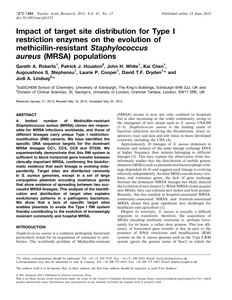Roberts, GA; Houston, PJ; White, JH; Chen, K; Stephanou, AS; Cooper, LP; Dryden, DT; Lindsay, JA
(2013)
Impact of target site distribution for Type I restriction enzymes on the evolution of methicillin-resistant Staphylococcus aureus (MRSA) populations.
Nucleic Acids Res, 41 (15).
7472 - 7484.
ISSN 0305-1048
https://doi.org/10.1093/nar/gkt535
SGUL Authors: Lindsay, Jodi Anne
![[img]](https://openaccess.sgul.ac.uk/102703/1.hassmallThumbnailVersion/gkt535.pdf)  Preview |
|
["document_typename_application/pdf; charset=binary" not defined]
Published Version
Download (6MB)
| Preview
|
Abstract
A limited number of Methicillin-resistant Staphylococcus aureus (MRSA) clones are responsible for MRSA infections worldwide, and those of different lineages carry unique Type I restriction-modification (RM) variants. We have identified the specific DNA sequence targets for the dominant MRSA lineages CC1, CC5, CC8 and ST239. We experimentally demonstrate that this RM system is sufficient to block horizontal gene transfer between clinically important MRSA, confirming the bioinformatic evidence that each lineage is evolving independently. Target sites are distributed randomly in S. aureus genomes, except in a set of large conjugative plasmids encoding resistance genes that show evidence of spreading between two successful MRSA lineages. This analysis of the identification and distribution of target sites explains evolutionary patterns in a pathogenic bacterium. We show that a lack of specific target sites enables plasmids to evade the Type I RM system thereby contributing to the evolution of increasingly resistant community and hospital MRSA.
Statistics
Item downloaded times since 23 Oct 2013.
Actions (login required)
 |
Edit Item |




